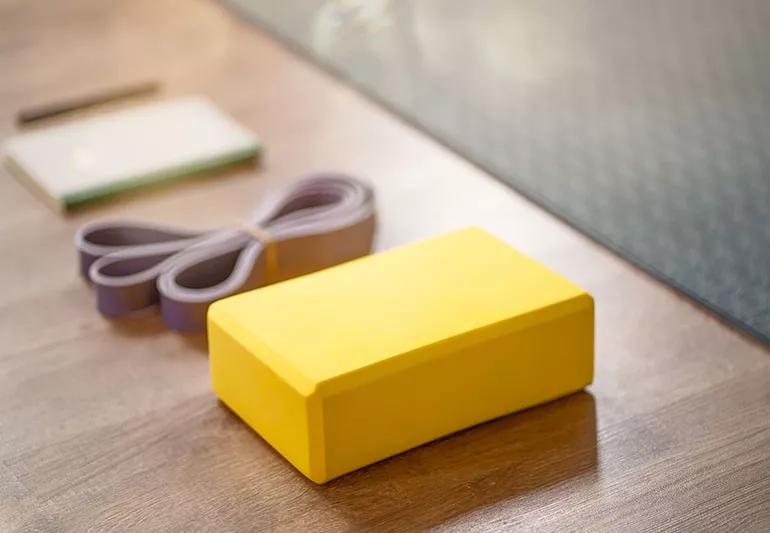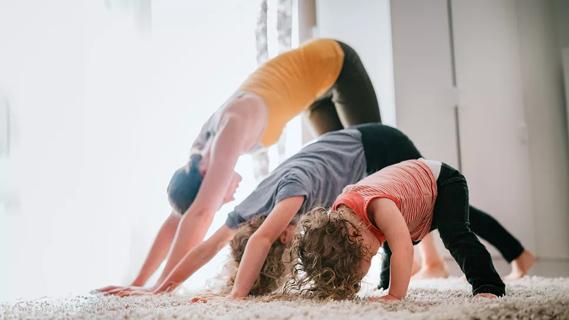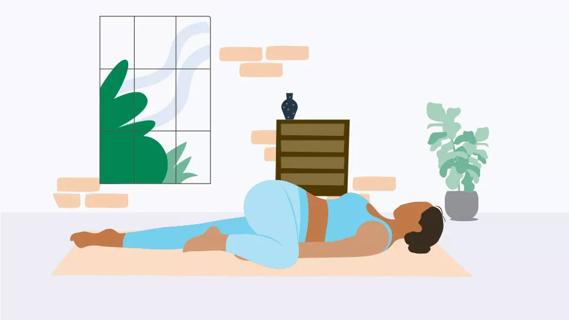A yoga specialist explains why they’re not a sign of weakness or inexperience

Raise your hand if you’ve jumped into a new physical activity headfirst.
Advertisement
Cleveland Clinic is a non-profit academic medical center. Advertising on our site helps support our mission. We do not endorse non-Cleveland Clinic products or services. Policy
And raise your hand if you ended up hobbling away from that activity because you did way too much way too soon. We’ve all been there because, well, we want to prove that we can do it — or that we’ve still got it.
But if you go into yoga with a “progress not perfection” mindset, you can save yourself from a world of physical hurt. And yoga props can be instrumental in keeping you safe and stable during classes or your at-home practice. If you’ve been avoiding them, yoga specialist Johanna Goldfarb, MD, RYT 200, has some good reasons for embracing them.
Yoga props are tools that you can use to make yoga poses more accessible or comfortable. It doesn’t matter if you’re new to yoga or you’ve been practicing for years, props offer something for everyone.
“As a yoga instructor, my mission is to always make yoga accessible to my students. This includes making the asanas, or poses, accessible to as many individuals as possible, regardless of starting level of fitness or flexibility. The purpose of props is to make the practice of yoga available to people no matter what their present level of flexibility is,” says Dr. Goldfarb.
You might be tempted to buy the same props that you’ve used in a studio or during a community class. But you can find good yoga props at all price points or even use items from around your house.
Advertisement
“When it comes to yoga props, there are no must-haves. However, the most useful props are a yoga block or two and a strap,” says Dr. Goldfarb.
Yoga blocks are exactly that — blocks made of foam, rubber cork or even wood. They come in handy when you’re doing standing poses that require balance and good alignment (the specific way that a pose needs to be done to prevent injury).
“For example, in triangle pose, if a student cannot reach the floor and maintain proper alignment in the pose, a block can be used to bring the floor to the student,” explains Dr. Goldfarb. “Instead of allowing a student to reach to the floor and turn their chest out of alignment, I can guide a student to keep their back straight and bring the forward arm towards the floor. And instead of straining to reach the floor, they can place their hand on top of a block.”
The thicker the material, the sturdier the block. Firmer blocks are great for standing or balancing poses. But if you want something to support your head, neck, spine or lower body while you’re lying down, you’ll want to get blocks that are made from a softer material. If you’re not sure what you need, you can ask your yoga instructor or get a feel for the different types of blocks at a sporting goods store.
If you’re practicing yoga at home and don’t have blocks on hand, Dr. Goldfarb says you can use large, heavy books.
Yoga straps are helpful for poses that require stretching. If you have tight hamstrings or shoulders, you’ll appreciate this yoga prop for sure. Yoga straps look like belts that are made of materials like hemp, cotton or nylon. They can range from six- to 10-feet in length and act as an extension of your limbs when holding poses.
“A strap can make a seated forward fold more effective for people with tight hamstring muscles. By adding our arms to this stretch, we can maintain alignment and keep the back straight. Without the strap, it is possible to simply reach forward while being mindful of the back, but the strap makes the pose much easier to do,” advises Dr. Goldfarb.
If you’re in a seated forward fold (legs out in front of you, feet flexed) and you can’t lean forward and grab your feet, that’s fine. You can take your strap and put it around the balls of your feet. Hold the strap in both hands and use it to keep your spine aligned as you sit upright. Don’t force yourself to bend forward. Just breathe and sit as tall as you can.
If you don’t have a strap, you can use an old necktie or even a T-shirt in place of one.
Advertisement
Many yoga studios have blankets for people to use. They might be made out of materials like recycled wool or cotton and come in a variety of thicknesses. Blankets are great for providing warmth if you’re lying down during a restorative or meditation practice. They can also provide additional support during poses or cushion your knees when you’re kneeling or on all fours.
“A blanket is another useful prop since most of us have one on hand. It can be used to support the knees or you can sit on it to support the hips. This might make sitting in cross-legged poses easier for some,” says Dr. Goldfarb.
Just like a block, a bolster can help bring the ground up to you during seated or reclined positions. This long, rectangular pillow can be placed under your knees during savasana or final resting pose to create space in your lower back. This allows your body to relax more and can provide relief for those who are living with lower back pain.
You can also sit on a bolster to support your hips during seated poses or you can rest your head and chest on one in balasana, or child’s pose, for more comfort. Bolsters can also make heart-opening poses, like a supported restorative backbend, more relaxing by allowing your chest, shoulders and abdomen to open up while your head, neck and spine are fully supported.
Advertisement
If you’re practicing at home and don’t have a bolster, you can use firm pillows or even roll up a large towel or blanket and place it where you want more support.
Yoga isn’t about how far you can push your body. Instead, Dr. Goldfarb says it should be a “union of the mind, body and breath.” But you can’t have that union if you’re uncomfortable or even in pain. So, when you walk into a class or set up for a yoga practice at home, make sure to grab what you need to ensure a smooth, serene and comfortable flow.
“Sometimes, in a studio, it can feel like the best yogis do not use props because they are so proficient with poses. And there can be a stigma attached to the use of props, either real (given the culture of the studio) or imagined. We also impose expectations on ourselves (needlessly),” notes Dr. Goldfarb. “But the role of the teacher is to keep reminding our students that we should practice where we are at that day. Learning to listen to our bodies and doing what is best each day is one of the primary goals of a yoga practice.”
Dr. Goldfarb also says that you deepen your yoga practice every time you step on your mat. When you force things, you put yourself at risk for injuries.
You might need a prop today but find that a month from now, you no longer need it. Or, you might have go-to props for every practice. Your comfort and stability matter most, so do what works best for you.
Advertisement
“A prop can become optional or we may continue to use it if it fits our practice. Either way, props can make our practice more satisfying by helping to promote the correct alignment and improving our flexibility so we can accomplish our personal goals,” says Dr. Goldfarb.
Learn more about our editorial process.
Advertisement

This gentle yoga stretch supports your spine, strengthens your core and calms your mind

Focus on inhaling and exhaling through 12 steps of a complete sequence

Stand tall and feel grounded with this foundational yoga pose

This transitional and restorative yoga pose provides a full-body stretch

Somatic yoga focuses on the sensation and experience of movement — not striking perfect poses

Balasana, or child’s pose, is a restorative full-body yoga technique

Kids’ yoga can help kiddos become more aware of their physical, mental and emotional selves

This mindful practice is designed to give you mental and physical relaxation

Babies can get congested easily, but you can calm their cough by keeping them hydrated, using nasal drops and running a humidifier

Weight loss may cause loose, sagging skin and muscle loss to your rear

Several conditions, like vitiligo and fungal infection, can cause a loss of pigmentation, leading to white spots or patches on your skin